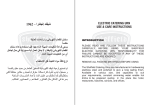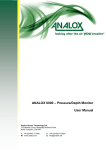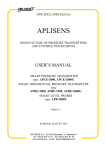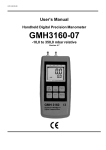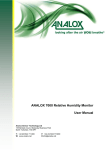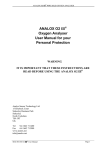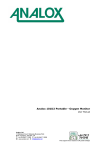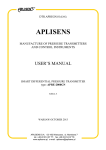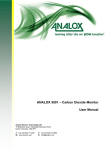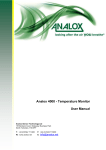Download ANALOX 9000 – Nitrogen Analyser User Manual
Transcript
ANALOX 9000 – Nitrogen Analyser User Manual Analox Sensor Technology Ltd 15 Ellerbeck Court, Stokesley Business Park North Yorkshire, TS9 5PT T: +44 (0)1642 711400 F: +44 (0)1642 713900 W: www.analox.net E: [email protected] Analox 9000 – Nitrogen Analyser – User Manual LIST OF CONTENTS 1 Important Safety Warnings .......................................................................2 1.1 Electrical Shock Hazard Warning ......................................................2 2 Operating Instructions...............................................................................3 2.1 Introduction........................................................................................3 2.2 Operating Conditions.........................................................................4 2.3 Calibration .........................................................................................4 2.4 Alarm Operation ................................................................................5 2.5 Alarm Setting .....................................................................................5 2.6 Battery Backup (Option) ....................................................................6 2.7 Sensor Replacement .........................................................................6 2.8 Interference .......................................................................................7 2.9 Sensor Fault Indication ......................................................................7 2.10 Repair And Service............................................................................7 3 Installation.................................................................................................7 3.1 Rear Panel Connections....................................................................8 4 Warranty Information ..............................................................................11 5 Specification .........................................................................................102 5.1 Electrical ........................................................................................122 5.2 Environmental................................................................................132 5.3 Mechanical ....................................................................................132 6 Oxygen Sensor Replacement Record ..................................................143 7 Disposal .................................................................................................14 Document Ref: 8K0-811-08 November 2010 Page 1 Analox 9000 – Nitrogen Analyser – User Manual 1 IMPORTANT SAFETY WARNINGS THIS PAGE SHOULD BE READ AND UNDERSTOOD BY ALL PERSONNEL CONCERNED WITH THE INSTALLATION, OPERATION AND MAINTENANCE OF THIS INSTRUMENT. The 9000 Instrument is NOT suitable for operation in a Hazardous Area, as defined by the British Standard BS 5345 Part 4. 1.1 Electrical Shock Hazard Warning The electrical power used in the 9000 System may be at a voltage sufficient to endanger life. Before carrying out any maintenance or repair, ensure that the equipment is disconnected from any Mains supply and tests made to ensure that isolation is complete. Document Ref: 8K0-811-08 November 2010 Page 2 Analox 9000 – Nitrogen Analyser – User Manual 2 OPERATING INSTRUCTIONS WARNING these instructions should be read and understood by all individuals who will be responsible for operation of this Analyser. The actions taken as a result of the measured levels must be in strict accordance with the Company and Government Regulations. 2.1 Introduction The Analox 9000 Nitrogen Monitor provides a continuous digital display of Nitrogen concentration, in the gas flowing through the sensor unit. The instrument displays the measured value on a 4 Digit red LED display over the range 0.1 to 100%. This is a dual resolution instrument, the resolution of the display may be selected at any time, with a front panel switch, which effectively suppresses the least significant digit without affecting the scaling of the instrument. The sensors used in the monitor are a Helium thermal conductivity sensor and an electrochemical Oxygen sensor. These sensor outputs are used by a microprocessor to calculate the Nitrogen (or balance) concentration in the gas flow. The instrument is easy to calibrate, using the ‘ZERO’, ‘CAL’ and ‘O2 CAL’ adjustments on the front panel. User adjustable high and low audio/visual alarms, are fitted as standard and these may be adjusted over the full range of the instrument. The optional relay outputs are available on the instrument rear panel. A flowmeter and controlling needle valve is mounted on the front panel of the monitor to control the flow rate across the sensor unit. Two power supply options are fitted on all instruments. Input 1 is a standard IEC 3 pin connector for AC power in the range 85 to 264VAC, 47 to 63 Hz WITHOUT switching or selecting. Input 2 is a standard co-axial battery charger type connector or a 2 way screw terminal type connector for low voltage power input in the following range: 12 to 32VDC Note the polarity of connection of DC is important. If fitted, the monitor also incorporates a re-chargeable nickel cadmium battery, which provides up to 1 hour of normal operation in the event of external power failure. External power status and internal battery condition are indicated by an LED on the front panel. Document Ref: 8K0-811-08 November 2010 Page 3 Analox 9000 – Nitrogen Analyser – User Manual 2.2 Operating Conditions The sample gas to be measured must meet the following conditions: Flowrate: 20ltr/hour Pressure: + 5psi Gauge (+ 350mbar Gauge) NOTE: IT IS IMPORTANT THAT THE SENSOR EXHAUSTS TO ATMOSPHERIC PRESSURE. IF AN EXHAUST PIPE IS USED FROM THE GAS OUT PORT ENSURE THAT IT IS NO GREATER THAN 20 METRES IN LENGTH AND IS A MIMIMUM OF 6mm IN DIAMETER. ALSO ENSURE THAT THE PIPE HAS NO KINKS IN IT OR IS RESTRICTED IN ANY WAY. Under no circumstances should any other equipment or restriction be connected to the exhaust port since any resultant back pressure will affect the accuracy of the readings obtained. 2.3 Calibration To ensure optimum performance, the instrument should have been switched on for at least 2 Hours, before any calibration adjustments are made. The following gases are required to calibrate the monitor: • 100% Helium • 100% Nitrogen • 5 to 100% Oxygen with a helium balance (the higher the O2 content the better) To correctly calibrate the instrument the following steps must be carried out in the order shown. 1) Zero Adjustment Connect the 100% Helium zero gas and adjust the flow rate to approximately 20ltr/hr. Allow a few minutes for the reading to stabilise. When steady, adjust the front panel ‘ZERO’ trimmer until the display reads ‘000.0’. 2) Span Adjustment Connect the 100% Nitrogen span gas and adjust the flow rate to approximately 20ltr/hr. Allow a few minutes for the reading to stabilise. When steady, adjust the ‘CAL’ trimmer until the display reads ‘100.0’. 3) Oxygen Sensor Adjustment Connect the Oxygen gas and adjust the flow rate to approximately 20ltr/hr. Allow a few minutes for the reading to stabilise. When steady, adjust the ‘O2 CAL’ trimmer until the display reads ‘000.0’. Document Ref: 8K0-811-08 November 2010 Page 4 Analox 9000 – Nitrogen Analyser – User Manual Note: when adjusting the ‘O2 CAL’ trimmer it is possible to put the instrument in its error state, which is signified by the reading jumping rapidly to an over range value. If no adjustment of the ‘O2 CAL’ trimmer will bring the reading to the desired point repeat the first two steps of the calibration procedure. If this doesn’t resolve the problem it is probable that the Oxygen sensor needs replacing, contact your local distributor or Analox Sensor Technology Ltd, for a replacement or further technical assistance. 2.4 Alarm Operation If an alarm condition occurs, the internal audible buzzer will sound intermittently and the yellow ‘HORN’ LED will flash, thereby identifying which instrument is causing the alarm. The appropriate red ‘HI’ or ‘LO’ LED will indicate the alarm level. The audible alarm can then be silenced by pressing the ‘MUTE’ button; this action will also turn off the yellow ‘HORN’ LED. If the reading is still in an alarm condition, the red ‘HI’ or ‘LO’ LED will continue to flash until the nitrogen concentration returns within the normal band. The red LED will then turn off. If an alarm condition occurs and the nitrogen concentration then returns to normal before the ‘MUTE’ button is pressed, then the audible and visual alarms will continue to be active until the ‘MUTE’ button is pressed. This facility allows the operator to be aware of any alarm occurrence whilst the instrument was unattended. The alarms have a built-in hysteresis of approximately 0.3% He to overcome ‘nuisance’ triggering when measuring near the set points. This means that if a high alarm occurs with a set point of 15.0%, then having been acknowledged by pressing the MUTE button, the alarm will not clear until the nitrogen level drops below 14.7%. 2.5 Alarm Setting Before any Adjustments are made to the ‘SET ALARM’ controls, the operator should release the locks on the knobs. This is done by moving the small lever located at the edge of the control until the knob turns freely. After adjustment, the locks should be reset in order to prevent accidental movement. The ‘SET HI’/ ‘SET LO’ toggle switch is normally biased to its central position to read the measured N2 level. The High alarm point is set by moving this switch upward and adjusting the ‘SET HI ALARM’ control knob until the desired High alarm trip level is displayed. The Low alarm trip point is set by moving the switch downward and adjusting the ‘SET LO ALARM’ control knob until the desired level is displayed. If the operator only wishes to check the currently set alarm points this may be done by just pressing the ‘SET HI’/‘SET LO’ switch to the appropriate position, and reading the levels on the LED Display. Document Ref: 8K0-811-08 November 2010 Page 5 Analox 9000 – Nitrogen Analyser – User Manual 2.6 Battery Backup (Option) If the external power supply to the instrument fails, the power supply circuitry in the instrument will automatically change over to the internal battery. When the instrument is being driven by its internal battery, the green ‘STANDBY’ LED on the front panel, will be lit and will remain on until external power is restored. The internal battery will provide normal operation for approximately 1 hour. When the battery has been discharged to such a level that instrument operation below this level would not be reliable, then a trip circuit will turn off the complete instrument and indicate this state by flashing the green ‘STANDBY’ LED at approximately 1 second intervals. 2.7 Sensor Replacement 2.7.1 Oxygen Cell When the instrument can no longer be calibrated by adjustment of the ‘O2 CAL’ control it is probable that the oxygen sensor capsule is exhausted and should be replaced. The sensors are push fit into a manifold on the rear panel of the monitor. To replace the oxygen sensor, switch off the instrument and remove the Oxygen sensor by pulling it out of the sensor manifold. Fit the new sensor and then switch the monitor on. The new sensor will require a period of approximately 1 hour to settle, after which the instrument should then be calibrated. The Oxygen Sensor Assembly has a life of approximately 2 years in normal air but this will be reduced if it is constantly exposed to higher concentrations of Oxygen. Conversely, if the sensor is normally exposed to lower concentrations of Oxygen, its life may be extended. The sensor must be replaced with an Analox Oxygen sensor type 9100-9212-94P, as this sensor is especially manufactured for this instrument. There are no serviceable parts in the sensor and cable assembly the entire unit must be replaced. Warning The sensor in the Analox 9000 is an electrochemical device and contains a caustic electrolyte. Always check to make sure that it is not leaking and do not allow it onto any part of your body or clothing. In the event that you do come into contact with the electrolyte wash the contaminated part with copious amounts of water Document Ref: 8K0-811-08 November 2010 Page 6 Analox 9000 – Nitrogen Analyser – User Manual WARNING If after handling the sensor your fingers or other parts of your body feel slippery or stings wash with a lot of water. If stinging persists get medical attention! 2.7.2 Helium Sensor The Helium sensor is not a consumable part and, if maintained, stored and used correctly, should last the life of the instrument. If the sensor does need replacing, maybe due to water damage, this can only be carried out by Analox and the Analox 9000 needs to be returned. 2.8 Interference Whilst all reasonable precautions have been taken within the Instrument circuitry and the case is RF screened, it is still possible, in common with other instruments, that very strong, local Radio Frequency fields could cause interference. This will show up as erratic readings on the LED Display. Where possible, RF sources such as Portable Radio Transmitters or Telephones should not be operated very close to the instrument. 2.9 Sensor Fault Indication Sensor faults and extreme over range states are indicated by the display reading a greatly over range value (>110%). If the monitor is in this fault state, try and perform the calibration procedure. If the first two calibration gases create no change in the display reading, try adjusting the ‘O2 CAL’ trimmer until the reading returns to between 0.1 and 100%. If this is successful try to perform the full calibration procedure again. If the fault state persists contact your local distributor or Analox Sensor Technology Ltd for further assistance. 2.10 Repair and Service Apart from periodic recalibration, the Instrument has been designed to provide long, trouble-free service. However, in the event of a fault condition arising, contact your local distributor or Analox Sensor Technology Ltd. The Instrument contains complex, precision circuitry which requires special test equipment to ensure correct internal set-up and calibration. Internal repairs or adjustments by the user are therefore NOT recommended. A separate technical manual is available for approved service centres, from Analox Sensor Technology Ltd. 3 INSTALLATION The Analox 9000 Monitors are available in two forms: Document Ref: 8K0-811-08 November 2010 Page 7 Analox 9000 – Nitrogen Analyser – User Manual 1) Suitable for insertion in a 19 inch rack frame 2) Suitable for direct mounting in an existing instrument panel For details of dimensions, cut outs and mounting centres, refer to the mechanical specifications at the end of this handbook. The frame mounting version should be inserted in a suitable rack and secured by the 4 corner screws and bushes, supplied with the instrument. Refer to the connection details below. When fitting the panel mounting instrument, the screws and bushes should be left attached to the instrument, as supplied and the whole assembly inserted into the panel, easing the bushes into the 10mm holes. Tightening the 4 screws will expand the bushes, locking them into the panel. If the instrument is subsequently removed from the panel, it is only necessary to remove the screws – the bushes should remain captive in the panel. 3.1 Rear Panel Connections All Electrical inputs to and outputs from the Instrument are connected via various sockets and terminals on the rear panel of the Instrument. All connections are identified by labels on the rear panel but are repeated here for convenience. Power Supply Power for the instrument may be derived from 1 of 2 options: 1) AC power in the range 85 to 264VAC, 47 to 63 Hz and connected via a standard IEC 3 pin plug/socket. A suitable lead is supplied with the instrument. Note that NO voltage selection is required when using this input – the instrument will operate from any voltage within the stated range. The fuse for this power input is mounted in the rear panel and is rated at 1 Amp ‘T’ type. 2) Low voltage DC in the range 12 to 32V with a ripple not exceeding 1 volt and connected via the battery charger type connector or the 2 way screw terminal type connector. THE LOW VOLTAGE DC SUPPLY SHOULD BE EXTERNALLY FUSED at a rating of 1 Amp using a ‘T’ type delay fuse. Note that connection polarity is important when using the DC input. Signal Outputs (Option) All signal outputs are made to removable, screw terminal plugs. The main connector is located down the right side of the rear panel, when viewed from the rear. IMPORTANT: PINS 15 AND 16 SHOULD BE LINKED TOGETHER. Two Analogue outputs, proportional to the measured input signal are available from the Instrument. Pin 8 provides 0-1 Volt representing 0 to Full scale and Pin 9 provides a 4-20mA current output representing 0 to full scale. Pin 7 is the Common connection for both outputs. The Voltage output must NOT be connected to a load less than 10,000 Ohms. The Current output is powered Document Ref: 8K0-811-08 November 2010 Page 8 Analox 9000 – Nitrogen Analyser – User Manual from an internal nominal 24 Volt supply and can operate into a load from 50 Ohms to 500 Ohms. Alarm Relays (Option) The Analox 9000 can be fitted with two relays which operate in conjunction with the HI and LO alarms. The relays have a single pole changeover contact arrangement, rated to switch up to 7 Amps @ 240VAC or 30VDC. The relays may be configured to be energised or de-energised, when the Instrument is in a non-alarm state. If the relays are configured to be in a normally energised state, this will provide a ‘Fail-Safe’ facility in that a total power failure will cause the relays to release and signal an alarm condition. Contact arrangement is shown on the rear panel. Instruments normally leave the factory with the relays configured to ENERGISE IN ALARM conditions. The ‘COM’ and ‘NO’ contacts will close, in an alarm condition. Document Ref: 8K0-811-08 November 2010 Page 9 Analox 9000 – Nitrogen Analyser – User Manual WARRANTY INFORMATION We provide the following Warranties for the Analox 9000: A 1 year sensor warranty. A 1 year electronics warranty. In both cases the Warranty period runs from the date of our Invoice. We warrant that the equipment will be free from defects in workmanship and materials. The Warranty does not extend to and we will not be liable for defects caused by the effects of normal wear and tear, erosion, corrosion, fire, explosion, misuse, use in any context or application for which the equipment is not designed or recommended, or unauthorised modification. Following a valid Warranty claim in accordance with the above, the equipment, upon return to us, would be repaired or replaced without cost or charge but in our discretion we may elect instead to provide to you which ever is the lesser of the cost of replacement or a refund of net purchase price paid as per our Invoice on initial purchase from us. We shall have no liability for losses, damages, costs or delays whatsoever. We shall have no liability for any incidental or consequential losses or damages. All express or implied warranties as to satisfactory or merchantable quality, fitness for a particular or general purpose or otherwise are excluded and no such Warranties are made or provided, save as set out in this Clause 7. In order to effectively notify a Warranty claim, the claim with all relevant information and documentation should be sent in writing to: Analox Sensor Technology Limited 15 Ellerbeck Court Stokesley Business Park Stokesley North Yorkshire TS9 5PT Or by e-mail to : [email protected] Or by Fax to : +44 1642 713900 We reserve the right to require from you proof of dispatch to us of the notification of Warranty claim by any of the above alternative means. The equipment should not be sent to us without our prior written authority. All shipping and Insurance costs of returned equipment are Document Ref: 8K0-811-08 November 2010 Page 10 Analox 9000 – Nitrogen Analyser – User Manual to be born by you and at your risk. All returned items must be properly and sufficiently packed. Document Ref: 8K0-811-08 November 2010 Page 11 Analox 9000 – Nitrogen Analyser – User Manual 4 SPECIFICATION 4.1 ELECTRICAL Range 0.1-100% N2 Sensor Type Helium Thermal Conductivity sensor with microprocessor linearization, temp and O2 cross sensitivity compensation. Oxygen sensor - Electrochemical Cell. Sensor Life Helium - up to 10 years (12 month warranty) Oxygen - up to 2 years in air (24 month graded warranty) Accuracy ±1.0% of Full Scale at Standard Temperature and Pressure Response Time 15 Seconds to T90 Warm up Time <15 Seconds Gas Flow Rate 20ltr/hr Display 4 Digit High-Brightness Red LED Power Supply 85 to 264VAC, 47 to 63 Hz 12 to 32VDC Outputs 0 – 1Volt (minimum load 10K ohms) 4 – 20mA Internally powered (optional) Alarm Relays 2 x Single Pole changeover, configurable to be (Optional) energised or de-energised when not in alarm state Rated at 7A 240VAC or 30VDC Optional Extras 1 Hour Battery Backup Document Ref: 8K0-811-08 November 2010 Page 12 Analox 9000 – Nitrogen Analyser – User Manual 4.2 ENVIRONMENTAL Operating 0 to +50oC Temperature Storage Temperature -5 to +50oC Relative Humidity 95% at 40oC Non Condensing Operating Pressure Atmospheric pressure ±350mbar (±5psi) 4.3 MECHANICAL Dimensions Depth Overall 235mm Rack Mount Version Depth behind Panel 300mm (min) Height Overall 129mm (3U) Width Overall 212mm (1/2 Rack) Dimensions Depth Overall 235mm Panel Mount Version Depth behind panel 300mm (min) Height Overall 133mm Width Overall 240mm Weight Weight 2.5 Kg Panel Cut-out Height 112.5mm Width 221mm Mounting Centres 4 x 10mm Holes Height 122.5mm Width 211.4mm Centred on Cut-out Document Ref: 8K0-811-08 November 2010 Page 13 Analox 9000 – Nitrogen Analyser – User Manual 6 OXYGEN SENSOR REPLACEMENT RECORD Serial Number In Service Date Document Ref: 8K0-811-08 November 2010 Page 14 Analox 9000 – Nitrogen Analyser – User Manual 7 DISPOSAL According to WEEE regulation this electronic product can not be placed in household waste bins. Please check local regulations for information on the disposal of electronic products in your area. Document Ref: 8K0-811-08 November 2010 Page 15


















